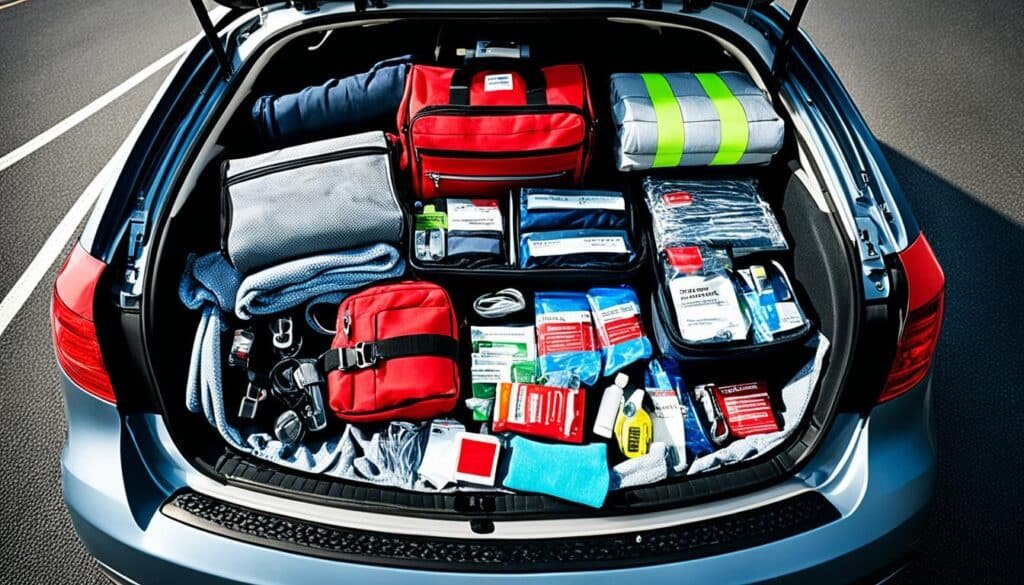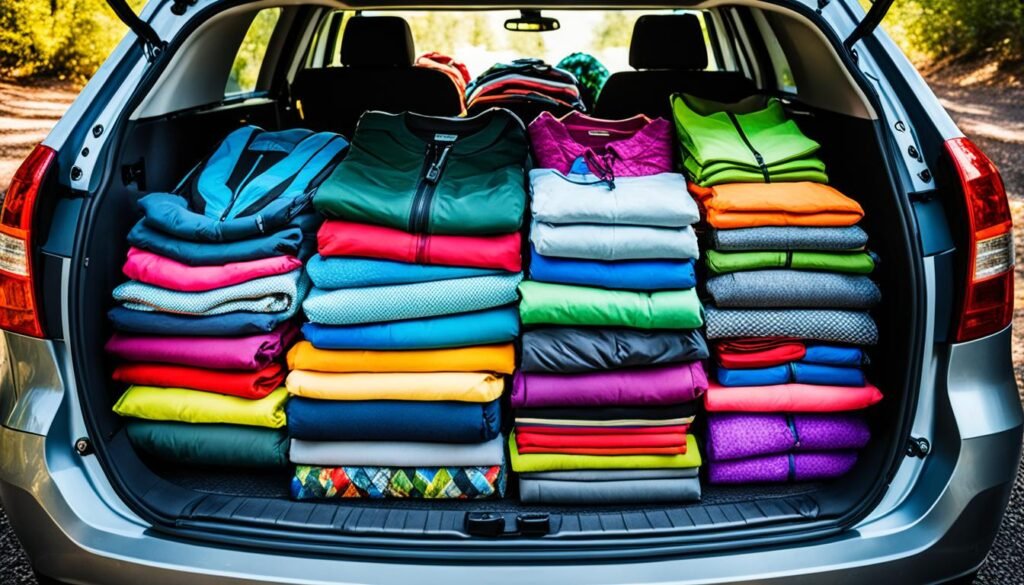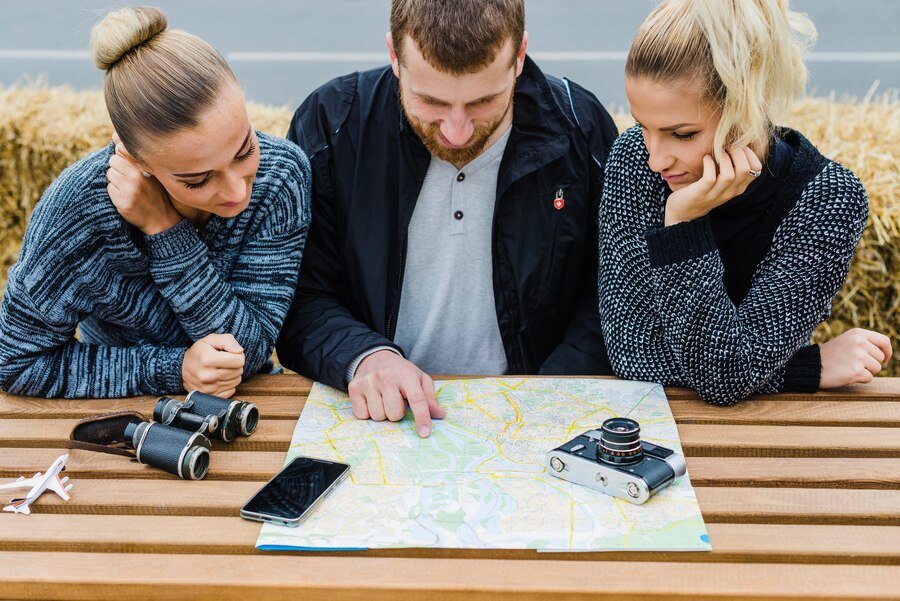Road Trip Planning Tips can be both exciting and overwhelming. Whether you’re embarking on a cross-country journey or exploring a scenic route closer to home, careful planning is key to ensure a smooth and enjoyable adventure on the open road. From determining the length of your trip and establishing a budget to choosing your route and accommodations, taking the time to plan ahead will help make your road trip a memorable experience.
Key Takeaways: Road Trip Planning Tips
- Determine the length of your trip and your main destination.
- Establish a budget to stay within your financial means.
- Plan an overview of your route using tools like Google Maps.
- Research and identify key stopping points and must-see attractions along your route.
- Create a detailed itinerary with travel dates, location durations, and estimated daily mileage.
Determine the Length of Your Trip and Your Main Destination
When embarking on a road trip, it’s essential to determine the length of your trip and your main destination. These two factors will shape the rest of your planning process, ensuring a smooth and enjoyable adventure on the open road.
Length of Trip: The first step in planning your road trip is deciding how long you’ll be on the road. Consider the number of days or weeks you have available for your adventure. A shorter trip may be perfect for a quick getaway, while a longer journey allows for more exploration and discovery.
Main Destination: Next, identify your main destination—the place that sparked your desire to plan a road trip in the first place. It could be a bustling city, a picturesque beach town, or a national park that’s been on your bucket list. Choose a destination that excites you and aligns with your interests.
By determining the length of your trip and your main destination upfront, you’ll have a clear focus for your road trip planning. You can then move on to other aspects, such as choosing the route, researching attractions, and making necessary reservations.
Take a look at the following example to get an idea of how you can integrate these two factors into your road trip planning:
Example:
You have two weeks of vacation time, and your main destination is the breathtaking Grand Canyon. With this information, you can start creating a road trip itinerary that includes the number of days you’ll spend at the Grand Canyon, as well as the time required for travel to and from the destination.
Whether you’re planning a short weekend getaway or an epic cross-country adventure, determining the length of your trip and your main destination early on will set the foundation for a memorable and well-planned road trip.
Establish a Budget for the Trip

Creating a budget for your road trip is crucial to ensure you stay within your financial means. Before embarking on your adventure, it’s important to consider all potential expenses and allocate funds accordingly. By planning your budget in advance, you can make informed decisions about your trip and avoid overspending.
When budget planning for your road trip, be sure to take into account the following travel expenses:
- Road Trip Budget: Determine the total amount you’re willing to spend on your adventure. This will serve as the foundation for all your budget planning.
- Gas: Estimate the amount of fuel you’ll need based on the distance you’ll be traveling and the fuel efficiency of your vehicle. Don’t forget to account for fluctuations in gas prices.
- Accommodations: Research different lodging options such as hotels, motels, campgrounds, or vacation rentals. Compare prices and book accommodations that fit within your budget.
- Meals: Plan your meals to determine how much you’ll need to spend on food. Consider cooking some of your meals instead of dining out to save money.
- Activities: Make a list of the activities and attractions you want to experience during your road trip. Research the costs associated with each activity and factor them into your budget.
- Additional Costs: Don’t forget to account for any additional expenses such as tolls, parking fees, souvenirs, and unexpected emergencies.
By setting a budget for your road trip, you can prioritize your spending and make the most of your travel funds. Remember to track your expenses as you go to ensure you stay on track with your budget. If you find yourself exceeding your budget in one area, look for ways to cut costs in other areas to maintain balance.
Sample Road Trip Budget
| Expense | Estimated Cost |
|---|---|
| Gas | $200 |
| Accommodations | $500 |
| Meals | $300 |
| Activities | $200 |
| Additional Costs | $100 |
| Total | $1,300 |
Remember, this is just a sample budget, and your actual expenses may vary depending on your specific plans and preferences. It’s always a good idea to budget a little extra for unexpected expenses that may arise during your trip.
Next, we’ll move on to planning an overview of your route so you can start visualizing your road trip itinerary.
Plan an Overview of Your Route

Mapping out your road trip route is a crucial step in ensuring a successful adventure. By planning an overview of your route, you can make the most of your trip and optimize your travel experience. Here are some tips on how to plan your road trip itinerary:
1. Decide on the Cities, Towns, or Attractions You Want to Visit
Start by deciding on the destinations you want to include in your road trip. Consider the cities, towns, or attractions that align with your interests and preferences. Whether you’re interested in exploring natural wonders, historical landmarks, or vibrant urban areas, identifying your must-visit locations will help shape your route.
2. Utilize Road Trip Planning Tools
Take advantage of modern technology and use road trip planning tools like Google Maps or dedicated road trip apps to plan your route. These tools can help you determine the most efficient and scenic route to your desired destinations. You can also use these tools to calculate the estimated travel time and distance between each stop, allowing you to schedule your trip more effectively.
3. Consider Scenic and Off-the-Beaten-Path Routes
While efficiency is important, don’t forget to factor in scenic and off-the-beaten-path routes. Road trips offer a unique opportunity to explore hidden gems and picturesque landscapes. Research alternative routes and include them in your plan to make your journey more memorable and visually captivating.
4. Allocate Sufficient Time for Each Stop
Ensure that you allocate sufficient time for each stop along your road trip route. Consider the attractions and activities available in each location and plan your itinerary accordingly. Avoid rushing through your itinerary and allow yourself enough time to immerse yourself in the local culture, explore the surroundings, and make lasting memories.
Remember, road trips are about the journey as much as the destination. Embrace spontaneity and leave room for unexpected discoveries along the way.
By following these tips and planning a comprehensive overview of your road trip route, you can embark on an unforgettable adventure filled with new experiences and breathtaking sights.
Research & Identify Key Stopping Points and Must-See Attractions Along Your Route

When planning your road trip itinerary, it’s crucial to conduct thorough research and identify the key stopping points and must-see attractions along your route. These stops will not only add excitement and variety to your journey but also provide you with opportunities to explore unique places and create memorable experiences.
Start by looking for national parks, state parks, landmarks, and other points of interest that align with your interests and preferences. Whether you’re a nature enthusiast, history buff, or adventure seeker, there’s bound to be attractions that cater to your travel style. Consider including iconic sites like the Grand Canyon, Yellowstone National Park, or the Statue of Liberty in your itinerary.
To ensure a well-rounded and diverse road trip experience, also include lesser-known gems that offer a rich cultural or natural experience. Discover hidden waterfalls, charming small towns, or street art-filled neighborhoods that are off the beaten path. These hidden treasures often provide a unique perspective and make for amazing photo opportunities.
“The freedom of a road trip allows you to explore not only the major attractions but also the hidden gems that make a journey truly special.” – Travel Enthusiast
Make a list of these attractions and use it as a guide to plan your daily stops and activities. By incorporating a mix of well-known landmarks and off-the-beaten-path discoveries, you’ll have a well-rounded road trip experience that caters to your interests and keeps you engaged throughout your journey.
Throughout your road trip, take the time to immerse yourself in the beauty and history of each destination. Stay curious, explore local cuisine, interact with locals, and embrace the spontaneity that comes with traveling on the open road. Remember, the journey is just as important as the destination.
Create Your Agenda: Choose Your Travel Dates, Decide How Long to Spend at Each Location, Create a Driving Schedule, and Include Estimated Daily Mileage

Now that you have your route and stops planned, it’s time to create a detailed agenda for your road trip. This will help you stay organized and make the most of your time on the road. Here are some key steps to follow:
Select Your Travel Dates
Start by choosing the dates for your road trip. Consider any specific events or activities that you want to experience along the way. Keep in mind the duration of your trip and the number of locations you plan to visit. It’s important to allow enough time at each stop to fully explore and enjoy the attractions.
Determine Location Duration
Next, decide how long you want to spend at each location on your road trip. This will depend on the significance of the place, the activities available, and your personal preferences. Some destinations may require more time to fully experience, while others may only be worth a day’s visit. Take into account the driving distance between each location to ensure a balanced itinerary.
Create a Driving Schedule
After deciding on the duration of your stay at each location, create a driving schedule. Consider the distance between each destination and the amount of time you want to spend driving each day. Take into account any scenic routes or detours you want to take along the way. It’s important to have a realistic driving schedule to avoid fatigue and make the most of the journey.
Include Estimated Daily Mileage
As you plan your driving schedule, don’t forget to include estimated daily mileage. This will help you gauge how long it will take to reach each destination and plan for any necessary stops or detours. Be mindful of your vehicle’s fuel efficiency and factor in breaks for meals and rest stops.
By following these steps, you can create a well-structured agenda for your road trip, allowing you to make the most of your travel dates, spend adequate time at each location, and have a realistic driving schedule. Take the time to plan carefully, and you’ll be rewarded with a smooth and enjoyable road trip experience.
Research and Choose Your Accommodations, Making Reservations as Needed

When planning a road trip, one of the most important aspects to consider is your accommodations. After a long day of exploring, you’ll want a comfortable place to rest and rejuvenate for the next leg of your journey. It’s crucial to research and choose the right accommodations that fit your preferences and budget.
There are various options available for road trip lodging, including hotels, vacation rentals, and campsites. Hotels provide convenience and comfort, with amenities such as private bathrooms, room service, and complimentary breakfast. Vacation rentals offer a home-like experience, giving you the opportunity to have your own space and cook your own meals. Campsites provide a unique outdoor experience, allowing you to be closer to nature and enjoy activities such as hiking and stargazing.
When researching accommodations, consider factors such as location, amenities, and reviews. Identify the type of accommodations that align with your travel style and preferences. If you prefer a more central location, look for accommodations near popular attractions or city centers. If you’re looking for a quiet and secluded experience, consider accommodations away from the hustle and bustle.
“Choosing the right accommodations can make a big difference in the overall experience of your road trip. It’s important to find a place that makes you feel comfortable and suits your needs.”
Once you’ve narrowed down your options, it’s time to make reservations. Making reservations in advance is especially important during peak travel seasons when accommodations can quickly book up. By securing your reservations early, you’ll have peace of mind knowing that you have a place to stay along your route.
When making reservations, be sure to provide accurate dates and the number of guests. Double-check the reservation details to avoid any confusion or misunderstandings. If you have any special requests or requirements, such as a specific room type or accessibility needs, communicate them to the accommodation provider in advance.
Remember, flexibility is key when it comes to road trips. While it’s important to have accommodations booked, also allow room for spontaneity and unexpected discoveries along the way. The beauty of a road trip is the freedom to adjust your plans and go with the flow.
Benefits of Planning and Reserving Accommodations
Planning and reserving accommodations in advance offers several advantages:
- Peace of mind knowing you have a place to stay
- Access to a wider range of accommodation options
- Potential cost savings through early booking discounts
- More time for researching and comparing accommodations
- Ability to make necessary arrangements for specific needs or preferences
By taking the time to research and choose your accommodations, as well as making reservations as needed, you’ll set yourself up for a comfortable and enjoyable road trip experience.
| Accommodation Option | Pros | Cons |
|---|---|---|
| Hotels | – Convenience and comfort – Amenities and services available – Central locations |
– Higher cost compared to other options – Less of a “home away from home” experience |
| Vacation Rentals | – More space and privacy – Ability to cook your own meals – Home-like experience |
– Limited availability in certain areas – Additional cleaning fees or requirements |
| Campsites | – Closer to nature – Lower cost option – Opportunity for outdoor activities |
– Lack of amenities and services – Weather-dependent – Requires camping equipment |
Make Sure Your Vehicle is Tuned Up and Ready to Go, Including Emergency Supplies

Before embarking on your road trip, it’s crucial to ensure that your vehicle is in optimal condition for a smooth and safe journey. A thorough vehicle maintenance check and packing essential emergency supplies can help you avoid unexpected breakdowns or emergencies on the road.
1. Schedule a Tune-Up
Start by scheduling a tune-up with a trusted mechanic. They will inspect your vehicle’s engine, brakes, suspension, and other crucial components to ensure everything is functioning correctly. By addressing any potential issues beforehand, you can prevent major breakdowns during your road trip.
2. Check the Oil and Fluids
Regularly check and change your vehicle’s oil, coolant, transmission fluid, and windshield wiper fluid. Low or dirty fluids can damage your engine or impair visibility, compromising your safety on the road. Topping up or replacing these fluids before your trip is essential.
3. Ensure Proper Tire Inflation
Your vehicle’s tires play a significant role in maintaining traction and stability. Check the tire pressure using a pressure gauge and inflate them to the recommended levels. Properly inflated tires minimize the risk of flats, provide better fuel efficiency, and enhance overall handling.
4. Pack Essential Emergency Supplies
Every road trip should include a well-stocked emergency kit. Here are some essential supplies to consider:
- A spare tire, jack, and lug wrench, in case of a flat tire
- Jumper cables to jump-start your vehicle if the battery dies
- A basic toolkit with wrenches, screwdrivers, and pliers for minor repairs or adjustments
- A first-aid kit with bandages, antiseptic solution, and other medical essentials
- A flashlight with extra batteries for emergencies that occur at night
- Flares or reflective triangles to alert other drivers in case of roadside emergencies
- Extra water, non-perishable food, and blankets in case you get stranded
By being prepared with these emergency supplies, you can handle unexpected situations confidently and ensure the safety and well-being of everyone on the trip.
With your vehicle in top shape and emergency supplies packed, you’re ready to hit the road with peace of mind.
Pack for the Trip Based on Your Destination and Activities

When planning a road trip, packing smartly is essential to ensure a successful and enjoyable journey. Consider the specific destination you’ll be visiting and the activities you’ll be participating in along the way. Here are some tips to help you pack the essentials:
1. Check the Weather
Before packing your bags, be sure to check the weather forecast for your destination. This will give you an idea of the appropriate clothing and gear you’ll need. Packing for road trip requires versatile clothing options that can adapt to changing weather conditions, such as layering pieces for cooler climates or lightweight and breathable clothing for hot summer days.
2. Pack Travel Essentials
Make a list of travel essentials that you’ll need throughout your road trip. This includes toiletries, such as toothbrushes, toothpaste, shampoo, and sunscreen, as well as any medications you may need. Don’t forget to pack a first-aid kit with basic supplies in case of emergencies.
3. Bring Snacks and Refreshments
Having snacks and refreshments on hand is essential for long drives and to keep everyone satisfied during the trip. Pack road trip snacks that are easy to eat on the go, such as granola bars, trail mix, or fresh fruits. Don’t forget to bring a reusable water bottle to stay hydrated throughout the journey.
4. Consider Destination-Specific Items
Depending on your destination and planned activities, there may be destination-specific items that you should pack. For example, if you’re heading to the beach, remember to bring towels, sunscreen, and beach gear. If you’re going hiking or camping, pack appropriate gear such as sturdy footwear, camping equipment, and insect repellent.
Pro Tip: Research your destination to understand any specific rules or requirements, such as dress codes or equipment restrictions. This will ensure you pack everything you need and avoid any unnecessary hassles along the way.
5. Entertainment for the Road
Make your road trip more enjoyable by bringing along entertainment options for the journey. Create a playlist of your favorite songs, podcasts, or audiobooks to keep you entertained on long drives. Consider packing travel games, books, or portable gadgets to keep everyone engaged during rest stops.
Remember, packing for a road trip should be a balance between bringing the essentials and avoiding overpacking. Keep in mind the limited space in your vehicle and prioritize items that are necessary for comfort, safety, and enjoyment along the way. With thoughtful planning and packing, you’ll be well-prepared for an unforgettable adventure.
Plan Your Snacks, Meals, Entertainment, and Activities for the Road

When embarking on a road trip, it’s important to plan ahead for snacks, meals, entertainment, and activities to make your journey comfortable and enjoyable.
Snacks for the Road
Having a variety of road trip snacks on hand is crucial to keep hunger at bay and maintain energy levels while driving. Pack road trip snacks such as granola bars, nuts, dried fruits, and pre-packaged snacks like chips or cookies. Don’t forget to bring a cooler for perishable items like fruits, sandwiches, or yogurt.
Meals on the Go
Planning meals ahead can save you time and money during your road trip. Consider preparing meals in advance and packing them in a cooler for easy access. Alternatively, research local restaurants or roadside eateries along your route to experience the local cuisine. Road trip meals can range from simple sandwiches and salads to delicious takeout from local diners.
Entertainment Options
Long hours on the road can feel monotonous, so it’s important to have entertainment options on hand. Create music playlists with your favorite tunes or discover new artists. Entertainment on the road can also include podcasts or audiobooks to keep your mind engaged. If you’re traveling with others, consider playing road trip games, such as “20 Questions” or “I Spy,” for some interactive fun.
Activities and Attractions
Maximize your road trip experience by planning activities and attractions along your route. Research road trip activities such as hiking trails, scenic overlooks, or museums to visit during rest stops or overnight stays. Include time for outdoor adventures like swimming, kayaking, or exploring local parks. These activities will add depth and excitement to your journey.
| Snacks | Meals | Entertainment | Activities |
|---|---|---|---|
| Granola bars | Sandwiches | Music playlists | Scenic overlooks |
| Nuts | Salads | Podcasts | Hiking trails |
| Dried fruits | Takeout from local diners | Audiobooks | Museums |
| Pre-packaged snacks | Local cuisine | Road trip games | Outdoor adventures |
By planning your snacks, meals, entertainment, and activities for the road, you can create an enjoyable and memorable road trip experience.
Review Your Plans and Confirm All Reservations Before Departure
Before hitting the road for your exciting road trip adventure, it’s essential to review your plans and confirm all reservations. Taking the time to double-check the dates, timings, and locations of your accommodations and attractions will ensure a smooth and hassle-free journey. By confirming your reservations, you can rest assured that everything is in order and make any necessary changes or adjustments beforehand.
Booking your accommodations and attractions in advance is a great way to secure your desired options, especially during peak travel seasons. However, it’s always a good idea to re-confirm your reservations closer to your departure date. This step allows you to verify any changes or updates and guarantees that your plans align with your expectations.
During the review process, pay attention to any additional charges or fees associated with your reservations. This way, you can budget accordingly and avoid any surprises when it comes time to settle the bill. Remember, reviewing your plans and double-checking reservations is an essential part of road trip preparation, ensuring a stress-free and enjoyable experience.
Double-Check: Dates, Timings, and Locations
When reviewing your plans, start by verifying the dates, timings, and locations of your accommodations and attractions. Ensure that there are no scheduling conflicts or discrepancies that could disrupt your itinerary. This step is particularly crucial if you made reservations well in advance or have made any changes to your original plans.
Confirming the locations is also essential, as it ensures that you have the correct addresses and directions to your desired destinations. Protip: Use online mapping tools or GPS devices to double-check the routes to avoid any confusion or unnecessary detours along the way.
Make Necessary Changes or Adjustments
If you come across any issues or need to make alterations to your reservations, take the time to do so before your departure. Whether it’s updating the number of guests, changing the duration of your stay, or modifying any special requests, addressing these changes in advance will save you from potential complications later on.
If you encounter any difficulties while re-confirming your reservations, such as availability or pricing concerns, reach out to the respective establishments or service providers immediately. They may be able to offer solutions or alternative options to ensure a smooth experience during your road trip.
Prepare for Last-Minute Surprises
While you have put in the effort to review and confirm your reservations, it’s always wise to prepare for any last-minute surprises. Keep a copy of all your booking confirmations or reservation details handy during your trip. This will make it easier to address any discrepancies or resolve any issues that may arise during your travels.
Should you encounter any unexpected changes, remain calm and composed. Utilize your contingency plan, such as contacting your accommodations or attractions directly, to seek alternatives or resolve the situation. Remember, flexibility and adaptability are valuable traits when embarking on a road trip adventure.
Inspirational Road Trip Planning Tools
Embarking on a road trip is a thrilling journey, and having the right tools can make it even more inspiring. Utilize online platforms like Roadtrippers or Google Maps to plan your route, discover hidden gems, and calculate travel time. Consider apps such as GasBuddy to find the cheapest fuel stops along the way, ensuring a budget-friendly adventure. Packing apps like PackPoint help organize essentials, while Spotify or podcasts keep spirits high with the perfect soundtrack. Remember, the road less traveled often leads to the most unforgettable experiences. Embrace spontaneity, stay curious, and let the road be your guide to inspiration.
3. Set a road trip budget
Setting a road trip budget is essential for a smooth and stress-free journey. Begin by estimating costs for fuel, accommodation, meals, and activities. Factor in unexpected expenses for emergencies or spontaneous detours. Utilize budgeting tools or apps to track spending and stay on target. Consider cost-saving measures like camping instead of hotels or preparing meals instead of dining out. Be realistic but flexible, allowing room for enjoyment without overspending. Remember, the goal is to create lasting memories without breaking the bank. By setting a budget, you ensure financial peace of mind and maximize the enjoyment of your adventure on the open road.
Things to consider when planning a road trip
When planning a road trip, several factors warrant consideration for a successful adventure. First, map out your route, including rest stops and attractions along the way. Check weather forecasts and road conditions to anticipate challenges. Ensure your vehicle is in optimal condition with regular maintenance and emergency supplies onboard. Plan accommodations in advance or embrace spontaneity with camping gear. Budget for fuel, food, and activities to avoid overspending. Pack essentials like maps, snacks, and entertainment for the journey. Communicate your itinerary with friends or family for safety. Flexibility is key; embrace detours and unexpected discoveries for a truly memorable experience on the open road.
Make sure your car is in top shape before you hit the road
Before embarking on your journey, ensure your vehicle is in prime condition. Schedule a thorough inspection, checking tires, brakes, fluids, and lights. Replace worn-out components and top up fluids as needed. Pack an emergency kit with essentials like a spare tire, jumper cables, and first aid supplies. Consider a professional tune-up for added peace of mind. Regular maintenance minimizes the risk of breakdowns and ensures a safe and smooth ride. Prioritize safety for yourself and fellow travelers by making sure your car is road-ready before hitting the highway.
Roadtrippers
Roadtrippers is a versatile online platform designed for travelers seeking adventure on the open road. It offers comprehensive trip planning tools, allowing users to map out routes, discover unique attractions, and find accommodations along the way. With its user-friendly interface and extensive database of points of interest, Roadtrippers simplifies the process of creating memorable journeys. Whether exploring local gems or embarking on cross-country adventures, Roadtrippers provides valuable insights and recommendations. From scenic drives to quirky roadside attractions, this platform empowers travelers to customize their experiences and make the most of every mile on their road trip adventures.
2. Plan your route
Planning your route is crucial for a successful road trip. Utilize maps and navigation tools to chart your course, considering scenic routes and points of interest. Factor in driving time, rest stops, and fuel stations along the way. Research road conditions and potential detours to ensure smooth travels. Flexibility is key; allow room for spontaneous discoveries and adjustments to your itinerary. Communicate your route with travel companions for safety and coordination. Whether opting for the fastest route or the road less traveled, thoughtful planning ensures a memorable and enjoyable journey from start to finish.
Your Guide to Planning the Ultimate Road Trip
Planning the ultimate road trip requires careful consideration and preparation. Start by selecting a destination and mapping out your route, taking into account scenic views and attractions. Set a budget for expenses such as fuel, accommodations, and meals. Ensure your vehicle is in top condition with regular maintenance and an emergency kit onboard. Pack essentials like maps, snacks, and entertainment for the journey. Embrace spontaneity but have a rough itinerary in place. Communicate your plans with trusted contacts for safety. Remember, the journey is as important as the destination, so enjoy the adventure and create lasting memories on the open road.
Also Read: Compelling Travel Logo Ideas For Your Brand
Conclusion
Planning a road trip can be exciting and overwhelming, but with proper preparation and organization, it can lead to unforgettable experiences and memories. By following these road trip planning tips, you can ensure a smooth and enjoyable adventure on the open road.
Remember to determine the length of your trip and choose your main destination. Establish a budget to stay within your financial means. Plan an overview of your route, research must-see attractions, and create a detailed itinerary. Make sure your vehicle is tuned up and packed with emergency supplies. Pack smartly based on your destination and activities. Plan your snacks, meals, entertainment, and activities for the road.
Lastly, before you depart, review your plans and confirm all reservations. Double-check dates, timings, and locations to avoid any last-minute surprises. With these road trip tips in mind, you’ll be well-prepared to embark on a journey filled with adventure, discovery, and endless possibilities. Bon voyage!
FAQs
Q: What is the importance of planning a road trip itinerary?
A: Planning a road trip itinerary helps you stay organized, makes the most of your time, and ensures you don’t miss out on must-see attractions along the way.
Q: How can I best plan a road trip itinerary?
A: To plan a road trip itinerary, research your route, decide on attractions to visit, allocate time for stops, and consider driving distances each day.
Q: What are some essential driving tips for a long road trip?
A: Ensure your vehicle is in good condition, take breaks regularly, stay alert while driving, and have emergency supplies on hand for a safe and enjoyable road trip.
Q: How should I pack for a road trip?
A: Pack essentials such as clothing, toiletries, snacks, maps, and entertainment items. Check the weather forecast and pack accordingly for a comfortable journey.
Q: What should I consider when planning a cross-country road trip?
A: Consider the distance, driving routes, accommodation options, sightseeing opportunities, budget, and duration of your cross-country road trip for a smooth and memorable experience.
Q: How can I make the most out of using Google Maps for my road trip?
A: Use Google Maps to plan your route, find attractions along the way, check for traffic updates, locate rest stops, and navigate efficiently during your road trip.
Q: What are some common road trip mistakes to avoid?
A: Avoid overpacking, not planning ahead for accommodations, driving long distances without breaks, and not checking your vehicle’s condition before embarking on your road trip.
Source Links
- https://thestokefam.com/how-to-plan-a-road-trip/
- https://stacker.com/travel/20-tips-ultimate-road-trip
- https://grad.uc.edu/student-life/news/archive/road-trip-pro-tips-for-your-next-adventure.html
